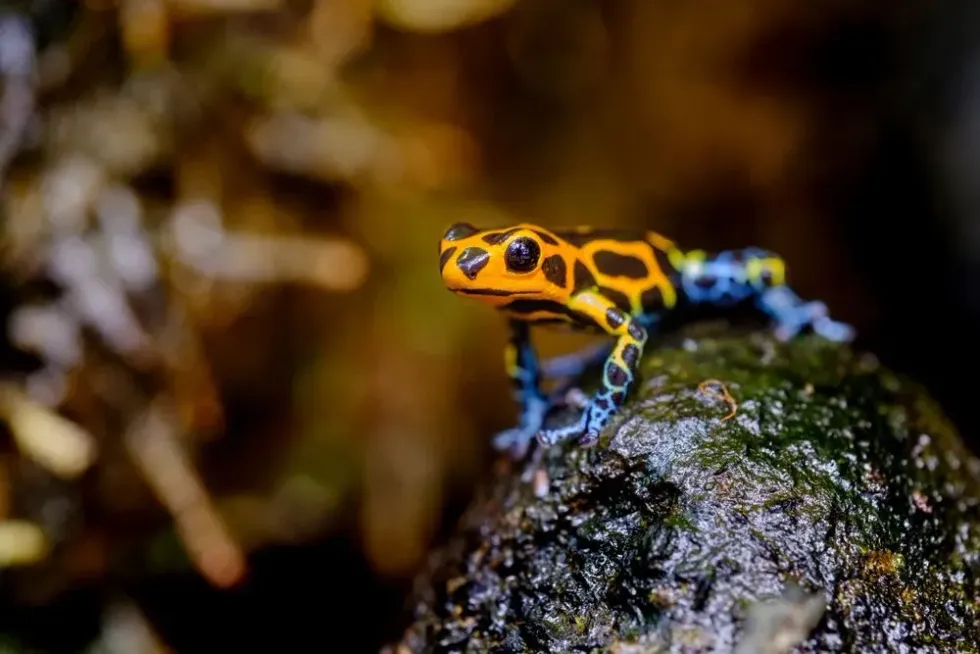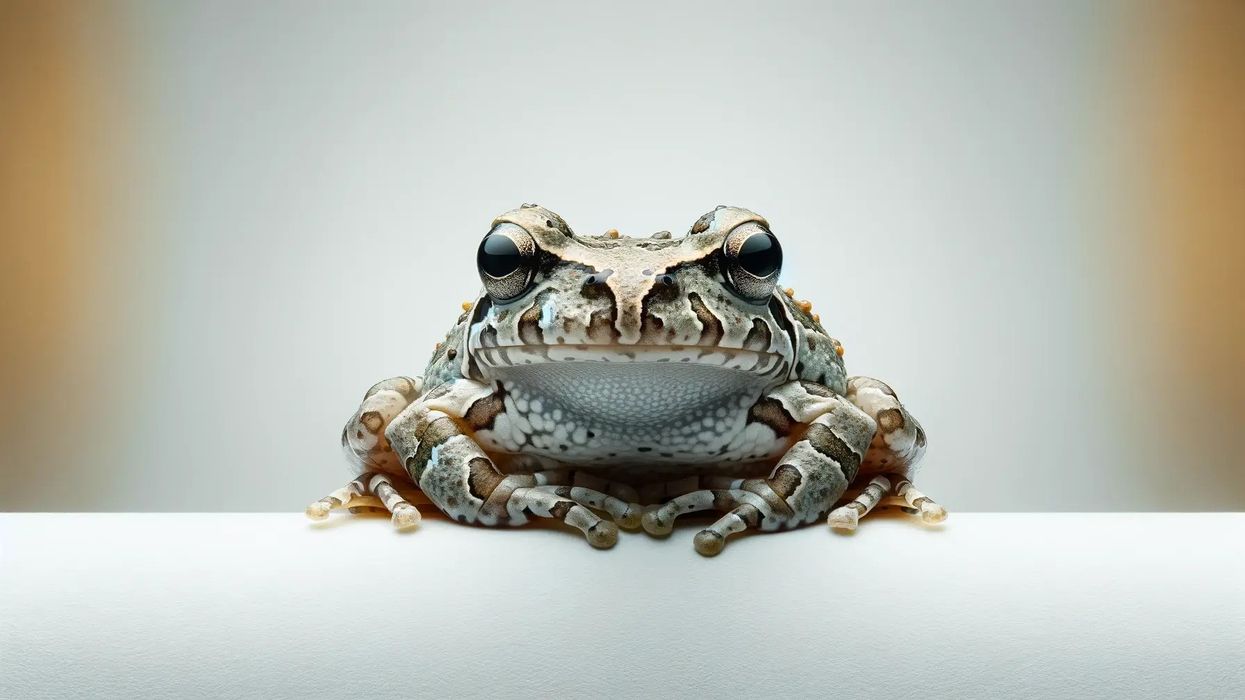The mimic poison frog (scientifically known as Ranitomeya imitator (formerly Dendrobates imitator)) is a colorful species of poison dart frog found in the rainforests of northern and northeastern Peru. These extremely tiny frogs measure an average of 0.5 in (1.3 cm) which is about the size of a human thumbnail.
They can mimic up to three other related and highly toxic species including Ranitomeya fantastica, Ranitomeya variabilis, and Ranitomeya ventrimaculata. Other common names include the poison arrow frog, imitating poison dart frog, and Peruvian poison dart frog.
If you like this article, check out our articles on the African clawed frog and the leopard frog too.
Mimic Poison Frog Interesting Facts
What type of animal is a mimic poison frog?
The mimic poison frog, Ranitomeya imitator, is a poison dart frog species.
What class of animal does a mimic poison frog belong to?
This poison dart frog species comes from the class Amphibia (or amphibians), a group of small vertebrates that need water and moist environments to survive. They are part of the family Dendrobatidae which are native to tropical Central and South America and are unique for are diurnal behavior.
How many mimic poison frogs are there in the world?
This frog has a relatively large and stable population in its wild habitats in aastern Peru. As there are an array of subspecies (described as morphs), the exact number of mimic poison frogs on earth is unknown.
Where does a mimic poison frog live?
The mimic poison frog (also known as the imitating poison dart frog) lives in tropical rainforests throughout the north-central region of eastern Peru. There are many subspecies of the mimic poison frog, each differentiated by a unique coloration (or morph) and behavioral pattern.
Common morphs include spotted, striped, banded, and Varadero. Mimicking the closely related striped Ranitomeya variabilis, the mimic poison frogs striped morph is the most widely distributed and particularly in the lower Huallaga River.
What is a mimic poison frog's habitat?
The Peruvian mimic poison frog can be found in montane wet and lowland tropical moist forests. They can be found near small streams, with plants (with water pools) that are a suitable and safe breeding habitat for their offspring.
Who do mimic poison frogs live with?
These frogs are highly social animals, and will often be found in pairs, or groups of five to six.
How long does a mimic poison frog live?
The average lifespan of this Peruvian poison dart frog is 8-12 years.
How do they reproduce?
The Ranitomeya imitator (R. imitator for short) is the only known monogamous amphibian and will find and mate with one partner during its lifetime. In their wet tropical habitat, the breeding season is all year round with most reproductive activity dependant on rainfall.
They will usually gather in large groups with males finding and marking a specific territory.
From here, a male will then call out to a wandering female, eventually finding a partner and taking them to a suitable breeding site. Eggs will usually be laid in phytotelmata (waters pools within plants) which make a dark, discrete and safe breeding habitat.
During reproduction, 1-40 eggs are laid by the female and fertilized by the male.
Post-hatching tadpoles will be carried to different plants on the backs of males, either in a group or one by one. These plants (with their own water pools) will operate like nurseries for the tadpoles.
Growing tadpoles will remain in these pools for extended periods until they reach adulthood.
During this time, both parents will care for their offspring and bring them food for several months. Like other poison dart frogs, the male is the primary carer however unique to this monogamous amphibian pair, the female will return periodically (usually once a week) to provide nutrient-rich unfertilized eggs for the tadpoles.
What is their conservation status?
These frogs are listed as a Least Concern.
Mimic Poison Frog Fun Facts
What do mimic poison frogs look like?
Mimic poisons frogs are a very colorful poison dart frog species. These tiny amphibians are wonderfully vibrant, although predominantly black, they are also often blended with one to two bright contrasting colors, usually green, blue, or yellow. This species is unique in its ability to imitate other more toxic poison frog species.
How cute are they?
Poison dart frogs are very captivating and insanely small animals which makes them incredibly cute. Their uniquely tiny size and enchanting array of vivid colors make them a marvel to the amphibian family and animal world.
How do they communicate?
Like other poison frogs, R. imitator communicates through a variety of vocal sounds that are used to attract mating partners, advertise and mark territories as well as express distress. Females are usually silent, whilst males are known to make high-pitched trill calls.
How big is a mimic poison frog?
These poison dart frogs are extremely tiny animals. A standard mimic poison dart frog will measure up to 0.5 inches (1.3 cm) although the largest size on record is 0.8 inches (2.2 cm).
How fast can a mimic poison frog move?
A mimic poison dart frog can travel at speeds of 10 mph (16 kph) which is not fast by any means. Due to its extremely tiny size, this speed is appropriate for how small this animal is.
How much does a mimic poison frog weigh?
Females weigh more than males, but on average, they weigh just 0.04 oz (1.25 g). This is one-two hundredth the size of a standard goldfish (8 oz (227 grams)), which means it would take 200 mimic poison dart frogs to make up the weight of a single goldfish!
What are the male and female names of the species?
Like other frogs, there are no sex specific names for male and female mimic poison frogs.
What would you call a baby mimic poison frog?
Baby mimic poison dart frogs are called tadpoles and then eventually froglets (young frogs).
What do they eat?
Mimic poison dart frogs are insectivorous, so their diet consists of many small insects including fruit flies, ants, mites, young crickets, springtails, and tiny beetles. Their food is caught and collected with their long and sticky tongues.
Tadpoles will eat insect larvae, algae, dead infections, and unfertilized eggs provided by females. The main food for captive frogs is 10-day old crickets and flightless fruit flies.
Poison dart frogs only have one natural predator the: the fire-bellied snake (Leimadophis epinephelus).
How far can they jump?
Although they spend a lot of time in trees, most mimic poison frogs will be found on the ground as they are too small to leap from tree to tree. The exact leap distance for these frogs is unknown.
Would they make a good pet?
Poison dart frogs are undoubtedly the most colorful and beautiful amphibians and are a popular choice for pets. When bred in captivity as tadpoles, they are completely non-toxic, as their poison comes from the food they eat in the wild.
In the right mimic poison frog habitat, the standard life span is four to eight years and unlike most frogs, they are diurnal which means they are active throughout the day.
These animals are known to make high-pitched trill calls. Overall, these frogs make great pets as they are easy to maintain, inexpensive long-term, and are housed in beautifully planted terrariums.
Did you know...
These frogs were discovered by an independent rainforest biologist Rainer Schulte in 1986. Monogamous pairing in animals is very rare, particularly amongst fish and amphibians.
However, in 2010, three biologists from East Carolina University discovered that these mimic dart frogs were the first confirmed species of monogamous amphibians. Growing tadpoles will eat unfertilized eggs provided by the female.
Like other poison frogs, males will be the main carers for tadpoles. The broader species of poison dart frogs received their name 'dart frogs' from Native Americans. In Native American history, it is believed that they used their toxic secretions to poison the tips and further strengthen their blowdart weapons.
Suction-like discs on their toes allow these tiny amphibians to skillfully climb. It takes several months for a tadpole to undergo metamorphosis and become an adult mimic poison dart frog.
Why is it called mimic poison frog?
The Ranitomeya imitator is called mimic poison frog for its tendency to imitate the colors and patterns of several other sympatric poison dart frogs. As such, their colorations are variable and will depend on the region it occupies and the local species it is imitating.
For example, near Yurimaguas, it mimics the longitudinal yellow stripe coloration of the closely related Ranitomeya ventrimaculata.
Can a poison dart frog kill a human?
Although all these frogs carry and release toxic secretions, not all are lethal. If touched or consumed, some can cause physical reactions like swelling, nausea, and paralysis. Whilst, others, like the golden poison frog, are one of the deadliest animals on earth, holding enough poison to kill up to 10-20 humans.
Are mimic poison frogs Endangered?
Mimic poison frogs (Ranitomeya imitator) are not Endangered. In their relatively large range throughout eastern Peru, they have stable reproduction patterns and populations. At the moment these animals are categorized as Least Concern, however destruction of their rainforest habitat, and increased demand in the pet trade will affect their survival.
Here at Kidadl, we have carefully created lots of interesting family-friendly animal facts for everyone to discover! For more relatable content, check out these spring peeper facts and blue poison dart frog facts pages.
You can even occupy yourself at home by coloring in one of our free printable Mimic poison frog coloring pages.










